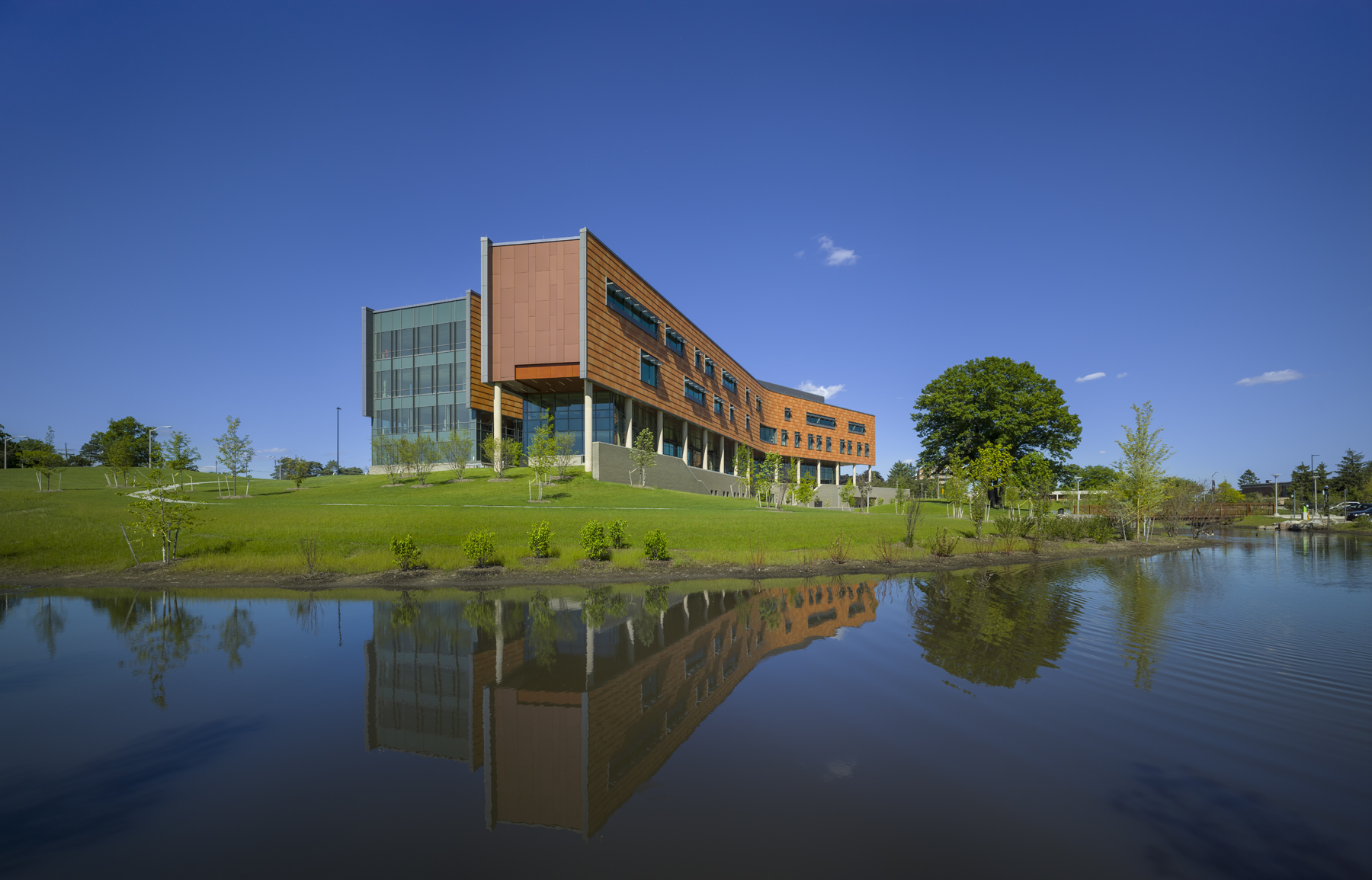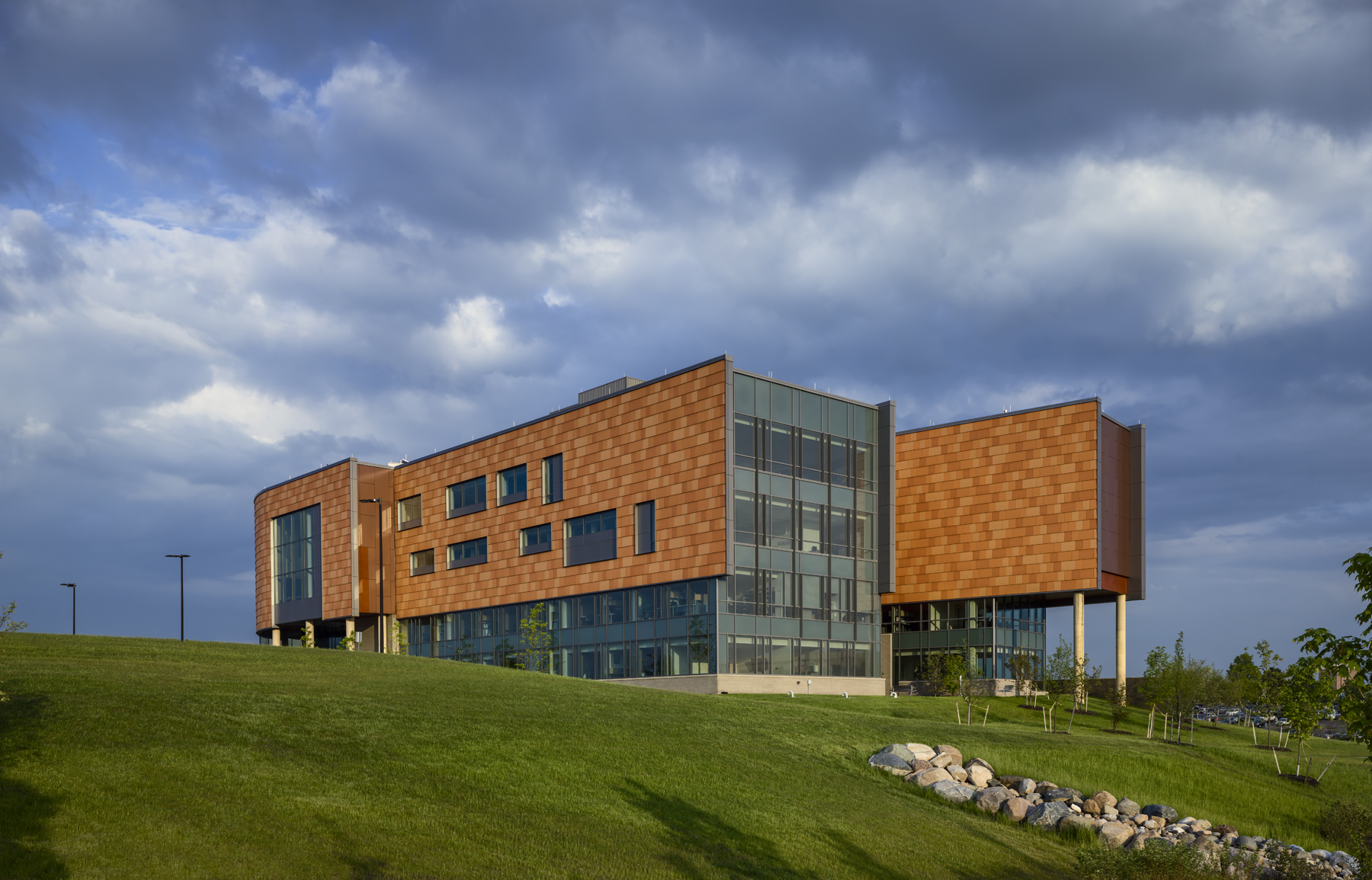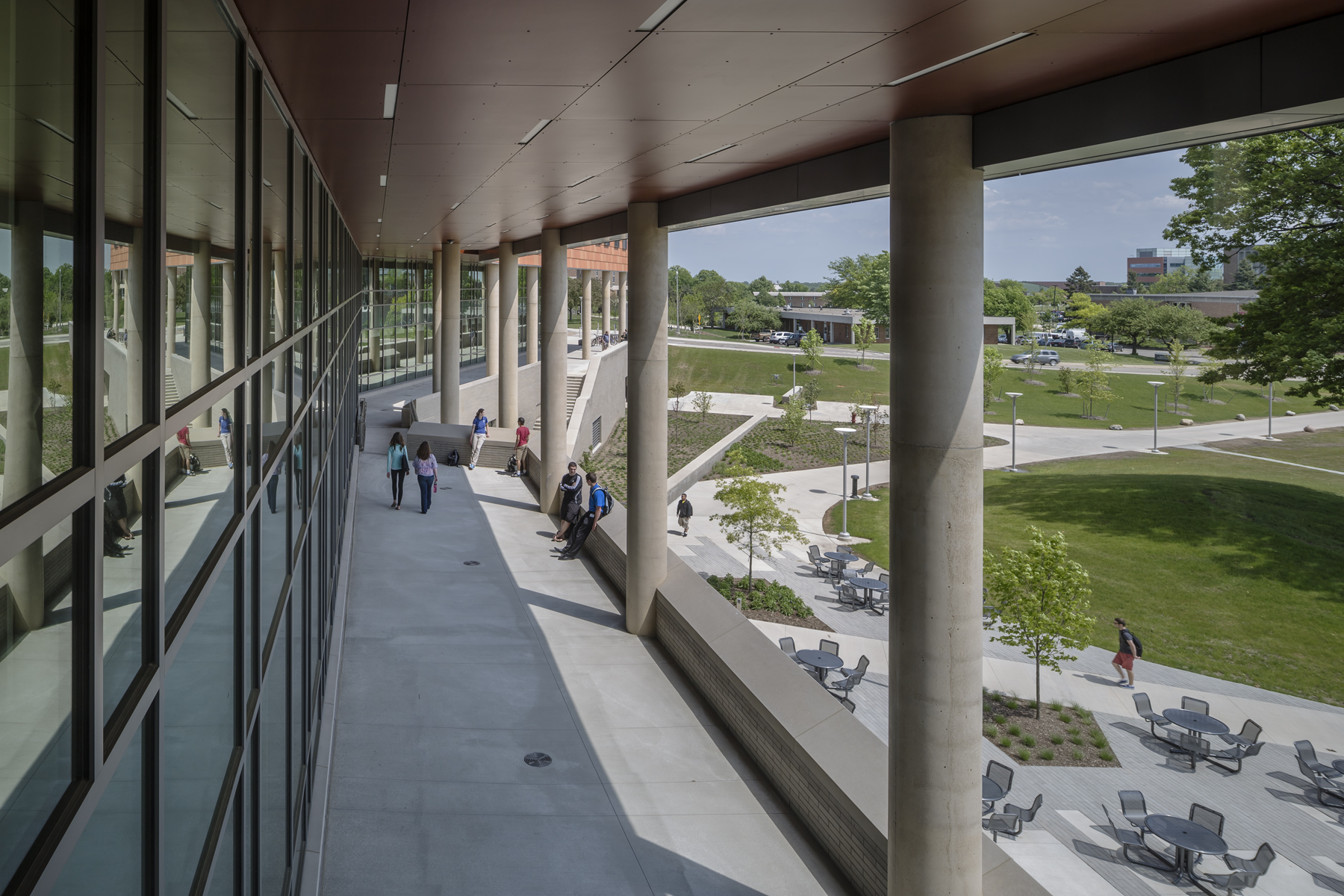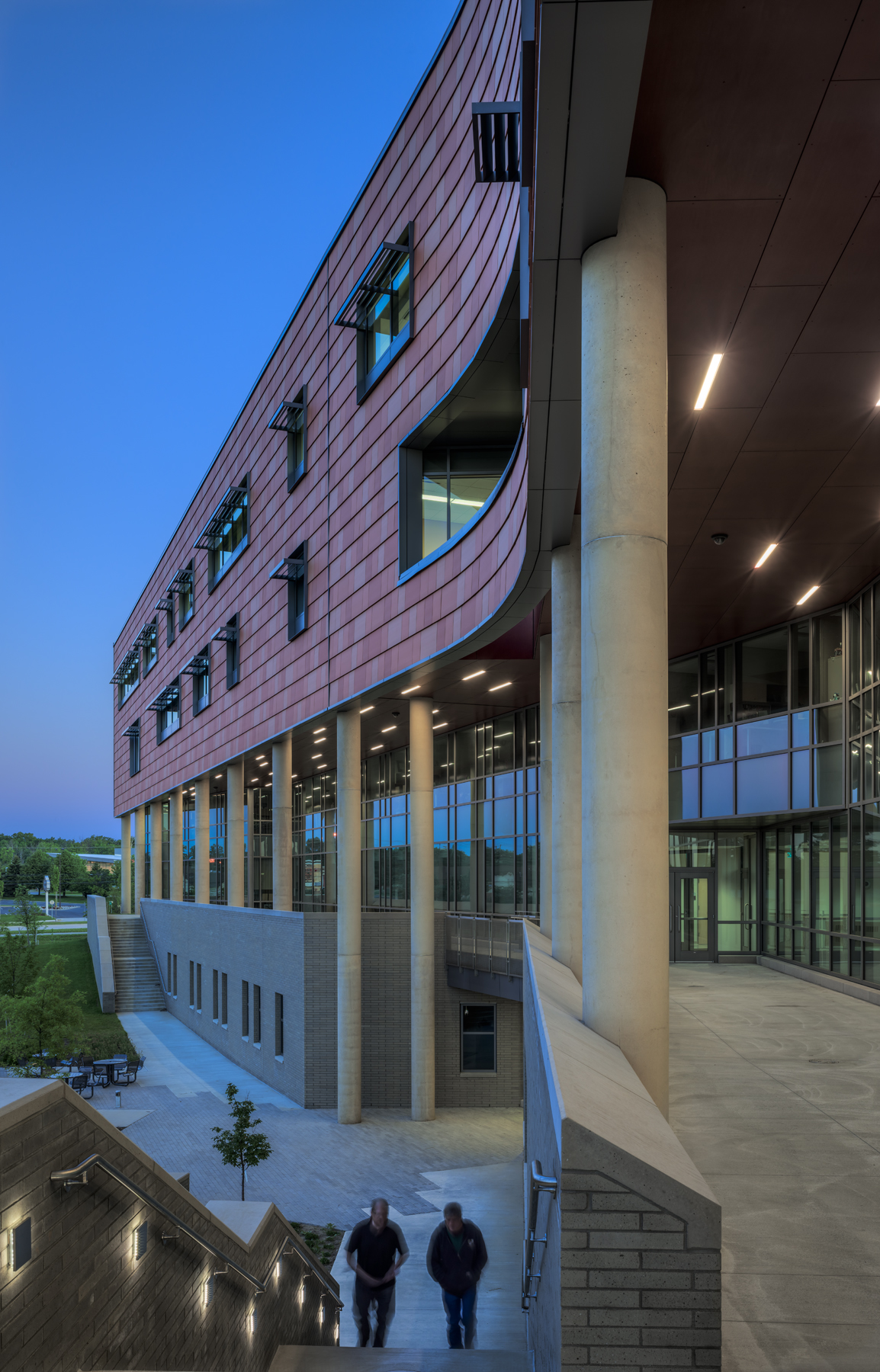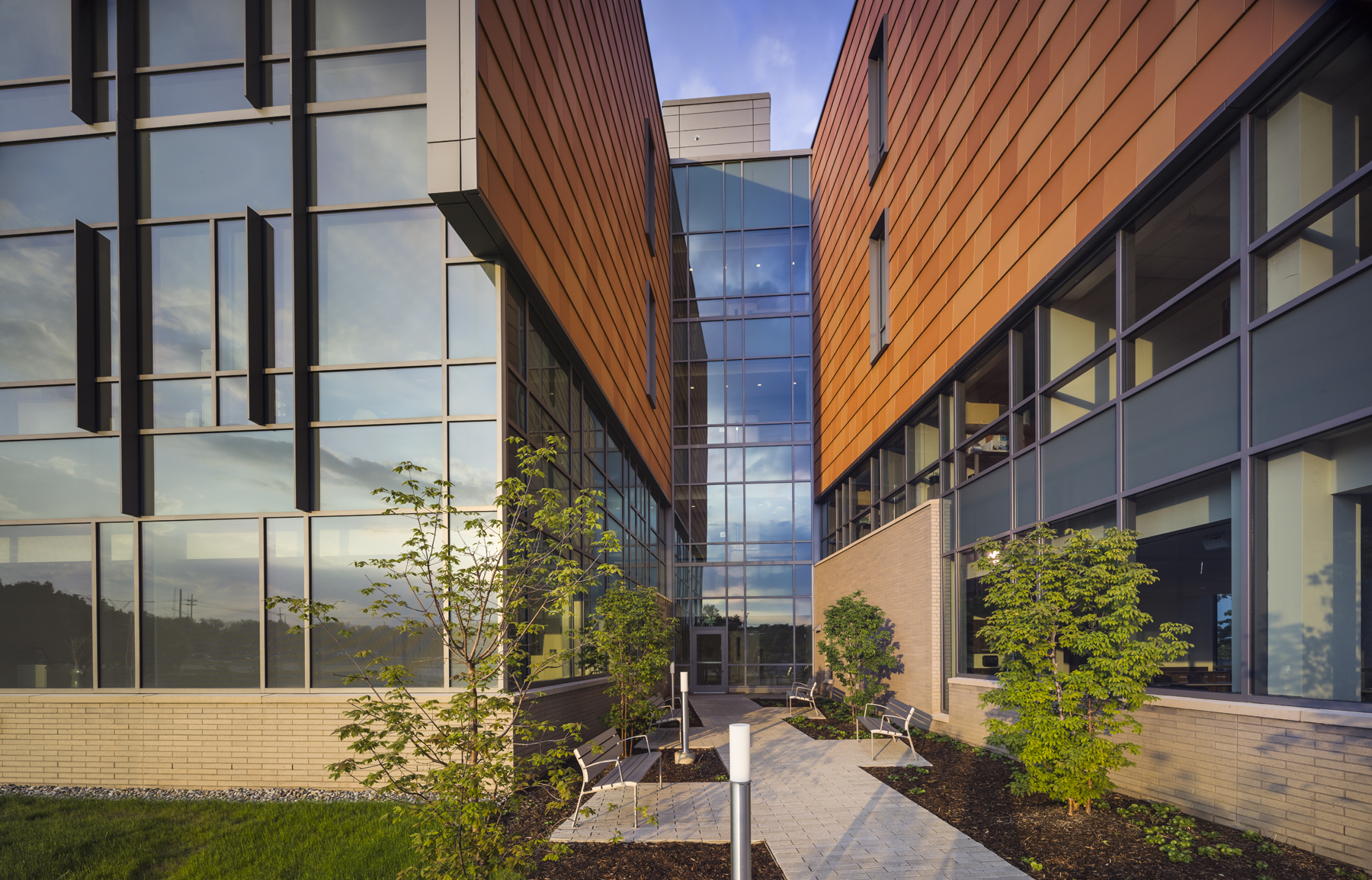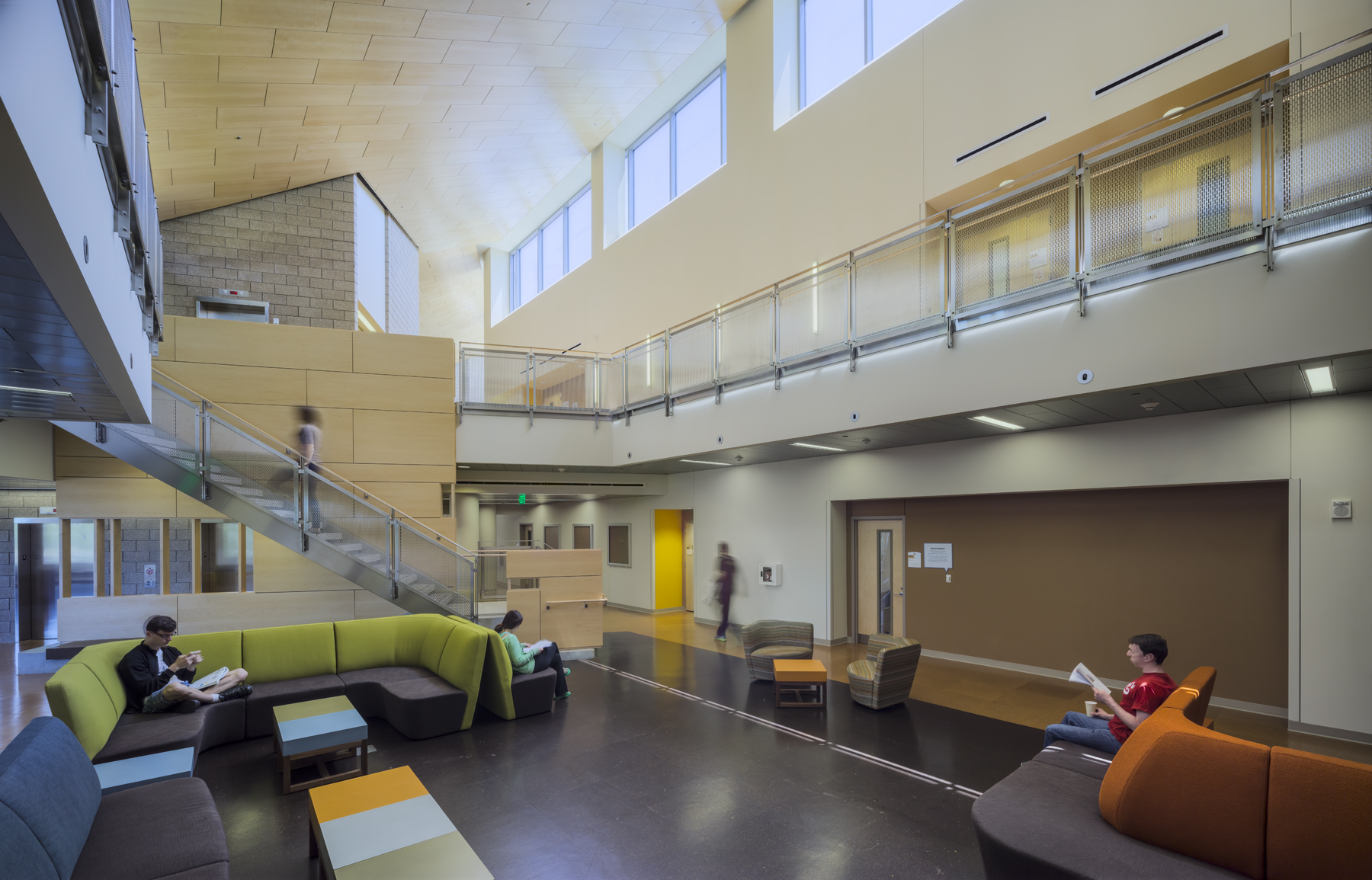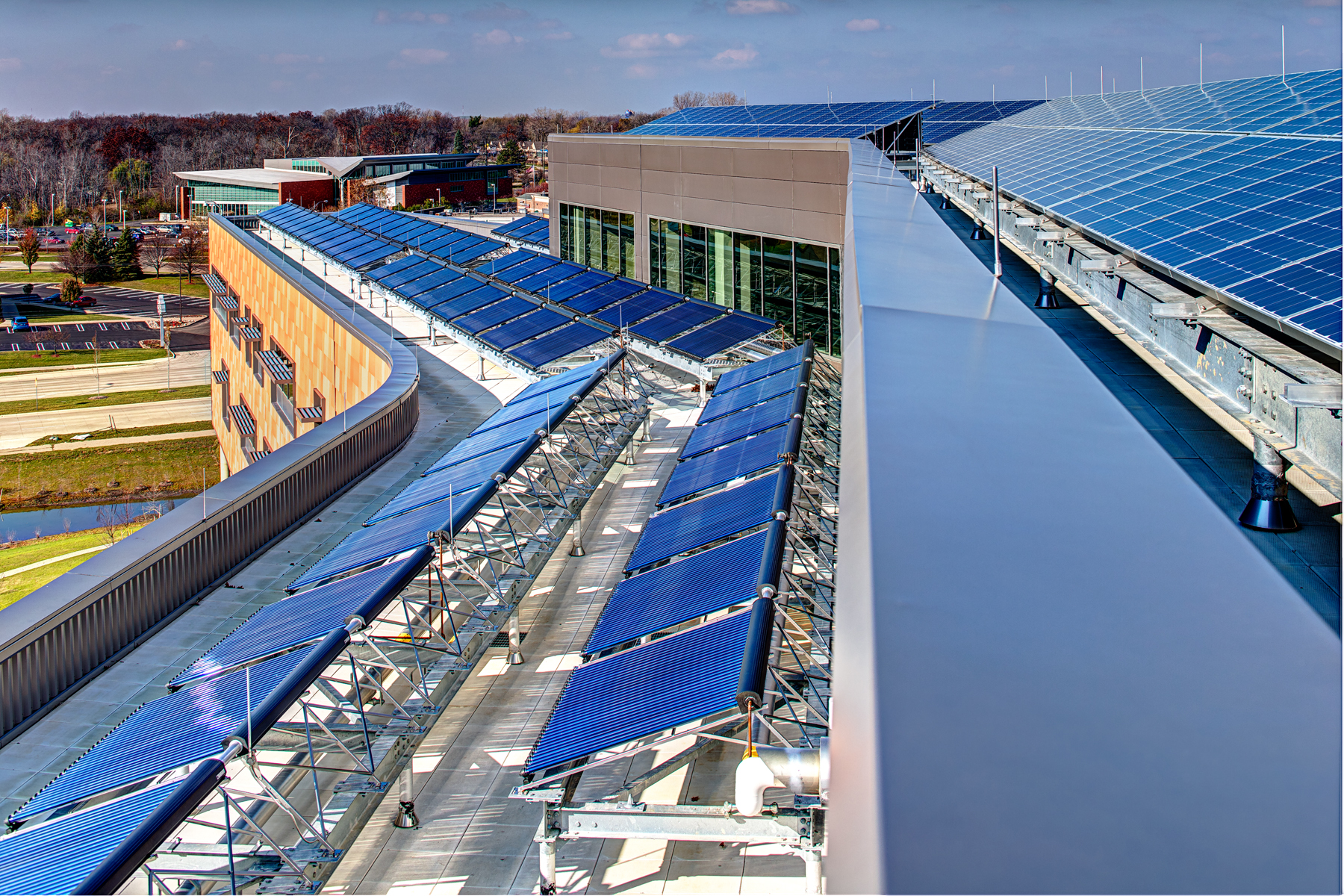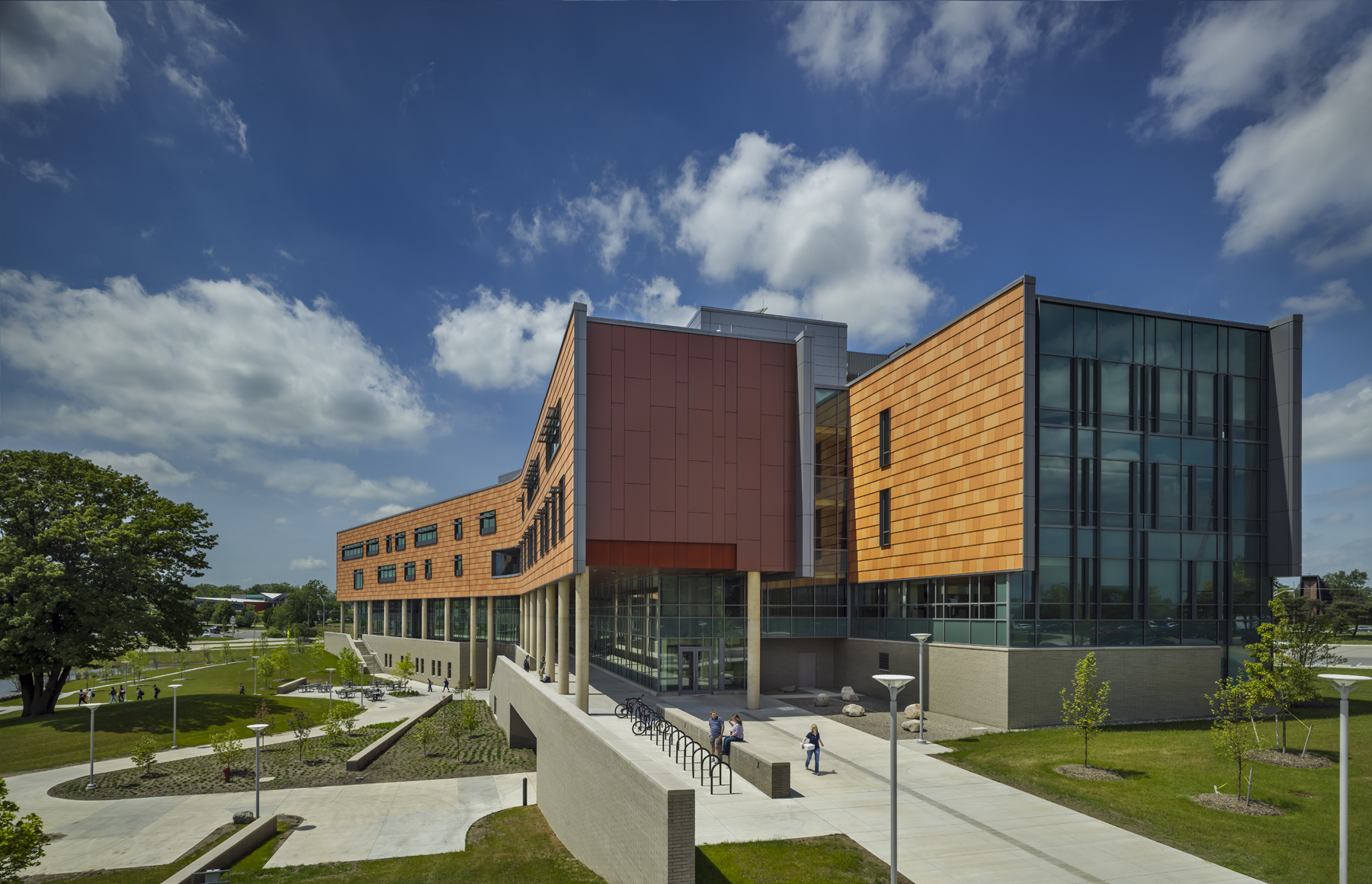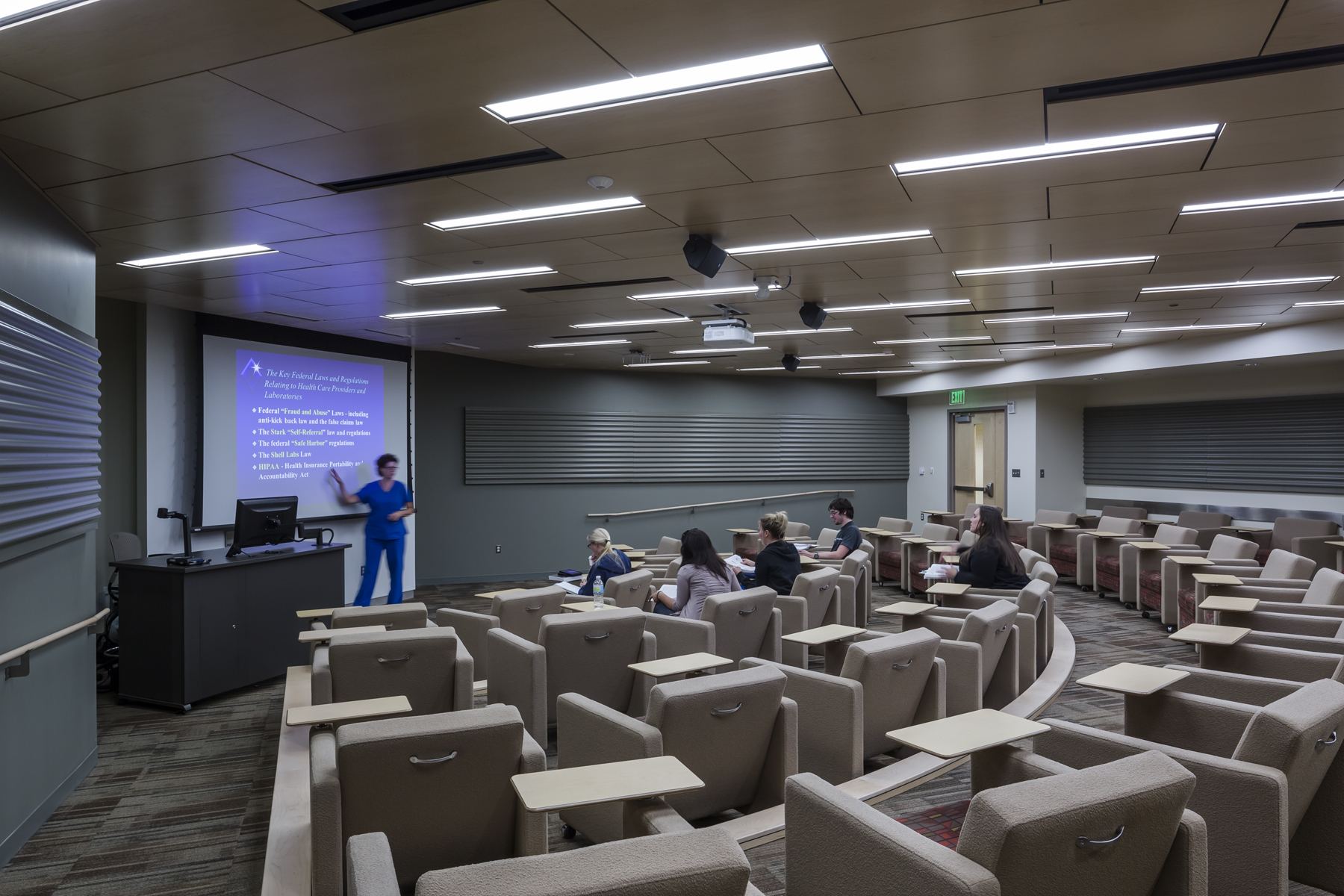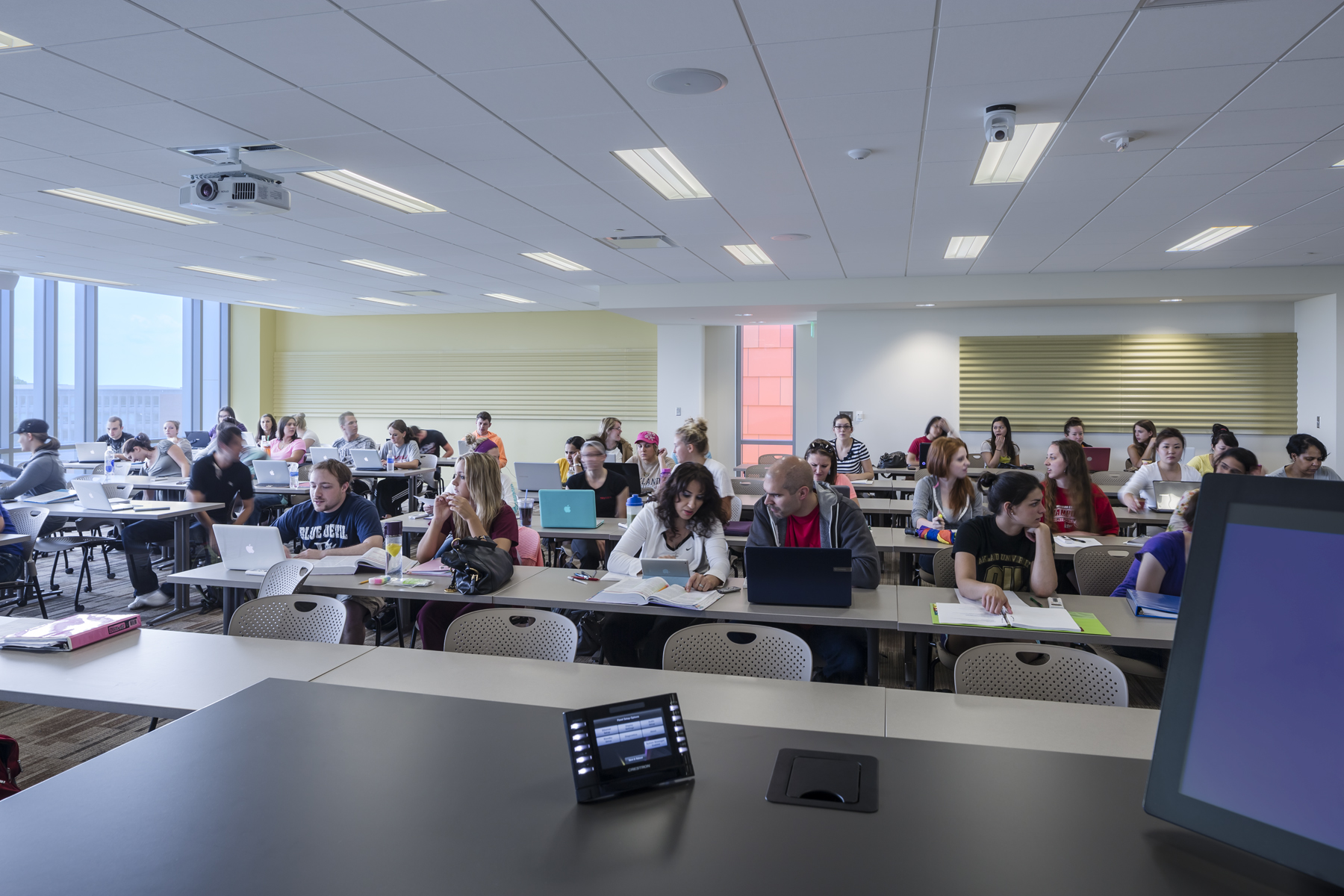The new $64 million Oakland University Human Health Building has become the first LEED Platinum certified building on a university campus in Michigan.
Designed by SmithGroupJJR, the 160,260-square-foot, five-story, terra cotta-clad building, built on the former site of a parking lot and an untended natural wetland, today features some of the industry’s most innovative, energy-efficient building systems and advanced sustainable design features.
The project’s primary funding of $40 million came from the State of Michigan legislature’s Capital Outlay Program. Then, to achieve the highest LEED rating – Platinum -- while staying on budget, Oakland University, assisted by SmithGroupJJR, successfully pursued a $2.7 million grant from the U.S. Department of Energy, allowing the project to proceed with a full geothermal and renewable energy system.
“The collaboration between Oakland University, SmithGroupJJR and The Christman Company truly benefitted our ability to design and build the most energy-efficient and sustainable building on any college campus in Michigan,” said Terry Stollsteimer, associate vice president, facilities management, Oakland University.
The facility’s energy systems are designed to save an estimated 35% in energy costs annually compared to the LEED prescribed “baseline” building.
A geothermal field, consisting of 340 wells built 320 feet underneath the university’s main parking lot, uses the earth as an energy source for heat pumps that efficiently provide heating and cooling for the building.
A total of 117 vacuum tube solar thermal panels provide “free” heat for the building in the wintertime, the desiccant dehumidification system in the summertime, and domestic water heating all year round. Four, 25,000-gallon underground tanks store any excess solar generated hot water until it’s needed.
A rooftop photovoltaic system, comprised of more than 200 solar panels covering 3,600 square feet, provides 45 kilowatts or 3% of the building’s power.
“Environmentally friendly buildings have shown to have positive effects on the quality of their occupants’ health, so it was easy for the university to decide that the new Human Health Building should be highly sustainable,” said Chris Purdy, AIA, LEED AP, SmithGroupJJR principal-in-charge for the project. SmithGroupJJR provided architectural design and development; mechanical, electrical, plumbing, structural and civil engineering; lab planning; interior design; landscape design and LEED certification and documentation.
The building’s environmental friendliness doesn’t end with the innovative, energy-efficient building systems. Outside, a grand porch created by the overhang of the upper floors protects faculty offices from the solar heat gain of a southern exposure. Exterior offices are outfitted with vertical sunshades and fritted glass to reduce glare and cut down on outside heat. Rainwater from the roof is collected and stored in a below-grade cistern, and used for site irrigation.
Inside the building, an elongated floor plan with floor-to-ceiling windows allows for abundant access to natural light and views of outdoor spaces. The interior’s use of recycled, regional and low-VOC materials includes sealed cork floors and bamboo cabinets, and walls are made with insulated cinderblock to reduce energy costs. Daylight and occupant sensors are used throughout the building to reduce energy use by occupants.
Directly south of the building is a towering, 100-year-old Oak tree that was integrated into the site design, rather than cleared. The site’s natural wetland was rehabilitated with native vegetation and invasive species were removed, thereby creating an outdoor lounge and gathering place for students.
About the Human Health Building, Oakland University
The Human Health Building (HHB) was conceived after increased student enrollment caused the university’s School of Nursing and School of Health Sciences to outgrow their separate facilities. The university envisioned a new building on the northwest corner of its 1,441-acre campus to allow the two schools a collaborative setting and an unprecedented opportunity for interaction among students, facility and community partners. Completed in August 2012, the HHB is the first structure constructed as part of the university’s proposed Health Quadrant Campus Master Plan, developed by SmithGroupJJR.
The HHB pairs advanced classrooms and hands-on instructional spaces with amenities that replicate those found in hospitals and community health centers – including a public clinic, simulation labs, and clinical and physical therapy labs. An emphasis was placed on student spaces; two-story, natural light-filled, “living room” areas on the fourth floor give students a place to gather before or after class. To learn more about the HHB from the design and construction team, go to: http://www.oakland.edu/?id=26078&sid=228
About SmithGroupJJR
SmithGroupJJR (www.smithgroupjjr.com) is a national leader in sustainable design, with 361 LEED Accredited Professionals on staff. The Oakland University HHB marks SmithGroupJJR’s 90th LEED certified project and its 11th LEED Platinum certification. The firm’s nationally recognized Learning Practice has completed the planning and design of educational facilities on over 350 campuses worldwide.
About LEED
The U.S. Green Building Council's LEED green building certification system is the foremost program for the design, construction and operation of green buildings. By using less energy, LEED-certified buildings save money for families, businesses and taxpayers; reduce greenhouse gas emissions; and contribute to a healthier environment for residents, workers and the larger community. For more information, visit www.usgbc.org.
Related Stories
Codes and Standards | Apr 12, 2024
ICC eliminates building electrification provisions from 2024 update
The International Code Council stripped out provisions from the 2024 update to the International Energy Conservation Code (IECC) that would have included beefed up circuitry for hooking up electric appliances and car chargers.
Urban Planning | Apr 12, 2024
Popular Denver e-bike voucher program aids carbon reduction goals
Denver’s e-bike voucher program that helps citizens pay for e-bikes, a component of the city’s carbon reduction plan, has proven extremely popular with residents. Earlier this year, Denver’s effort to get residents to swap some motor vehicle trips for bike trips ran out of vouchers in less than 10 minutes after the program opened to online applications.
Laboratories | Apr 12, 2024
Life science construction completions will peak this year, then drop off substantially
There will be a record amount of construction completions in the U.S. life science market in 2024, followed by a dramatic drop in 2025, according to CBRE. In 2024, 21.3 million sf of life science space will be completed in the 13 largest U.S. markets. That’s up from 13.9 million sf last year and 5.6 million sf in 2022.
Multifamily Housing | Apr 12, 2024
Habitat starts leasing Cassidy on Canal, a new luxury rental high-rise in Chicago
New 33-story Class A rental tower, designed by SCB, will offer 343 rental units.
Student Housing | Apr 12, 2024
Construction begins on Auburn University’s new first-year residence hall
The new first-year residence hall along Auburn University's Haley Concourse.
K-12 Schools | Apr 11, 2024
Eric Dinges named CEO of PBK
Eric Dinges named CEO of PBK Architects, Houston.
Construction Costs | Apr 11, 2024
Construction materials prices increase 0.4% in March 2024
Construction input prices increased 0.4% in March compared to the previous month, according to an Associated Builders and Contractors analysis of the U.S. Bureau of Labor Statistics’ Producer Price Index data released today. Nonresidential construction input prices also increased 0.4% for the month.
Healthcare Facilities | Apr 11, 2024
The just cause in behavioral health design: Make it right
NAC Architecture shares strategies for approaching behavioral health design collaboratively and thoughtfully, rather than simply applying a set of blanket rules.
K-12 Schools | Apr 10, 2024
A San Antonio school will provide early childhood education to a traditionally under-resourced region
In San Antonio, Pre-K 4 SA, which provides preschool for 3- and 4-year-olds, and HOLT Group, which owns industrial and other companies, recently broke ground on an early childhood education: the South Education Center.
University Buildings | Apr 10, 2024
Columbia University to begin construction on New York City’s first all-electric academic research building
Columbia University will soon begin construction on New York City’s first all-electric academic research building. Designed by Kohn Pedersen Fox (KPF), the 80,700-sf building for the university’s Vagelos College of Physicians and Surgeons will provide eight floors of biomedical research and lab facilities as well as symposium and community engagement spaces.



